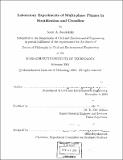Laboratory experiments of multi-phase plumes in stratification and crossflow
Author(s)
Socolofsky, Scott A. (Scott Alan)
DownloadFull printable version (16.04Mb)
Other Contributors
Massachusetts Institute of Technology. Dept. of Civil and Environmental Engineering.
Advisor
E. Eric Adams.
Terms of use
Metadata
Show full item recordAbstract
ocean, with applications ranging from carbon sequestration to the fate of oil and gas released from an oil well blowout. Experimental techniques included LASER induced fluorescence, shadowgraph visualization, salinity and dye concentration profiling, stratification generated by the two-tank method (using a 1.2 m square by 2.4 m deep, glass-walled tank), and crossflow generated by a towed source (using a 28 m long flume with 0.8 m square cross-section). Size spectra of droplets and bubbles were measured using a phase Doppler particle analyzer. To control particle size, sediment was also used; sediment size was measured using a micrometer. Slip velocities among all buoyancy sources ranged from 3 to 35 cm/s. Stratified experiments investigated the dependence of plume properties on the nondimensional slip velocity, UN= us/(BN)1/4 , where u, is the slip velocity, B is the total kinematic buoyancy flux, and N is the Brunt-Vaissld buoyancy frequency. First, UN predicts the transitions among characteristic plume types, and a new plume type was identified where the bubbles are dispersed by the intruding fluid. Second, non-dimensional variables (including characteristic length scales, volume and buoyancy fluxes, and fraction peeled) correlate with UN and were chosen to provide insight and calibration data to models. Crossflow experiments demonstrated fractionation (sorting of bubbles based on slip velocity) and separation (entrained fluid completely separating from the dispersed phase). Plumes were observed to have a fully-developed plume stage followed by separation at a critical height, hs, dependent on B, us, and the crossflow velocity, u[infinity]. A single-phase model was applied to these plumes by treating the separated fluid as a buoyant momentum jet. Stratified crossflow experiments showed that separation occurs at the lower of hs or the peel height in stagnant stratification (which correlates with UN).
Description
Thesis (Ph.D.)--Massachusetts Institute of Technology, Dept. of Civil and Environmental Engineering, 2001. Includes bibliographical references (p. 227-233).
Date issued
2001Department
Massachusetts Institute of Technology. Department of Civil and Environmental EngineeringPublisher
Massachusetts Institute of Technology
Keywords
Civil and Environmental Engineering.